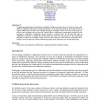Free Online Productivity Tools
i2Speak
i2Symbol
i2OCR
iTex2Img
iWeb2Print
iWeb2Shot
i2Type
iPdf2Split
iPdf2Merge
i2Bopomofo
i2Arabic
i2Style
i2Image
i2PDF
iLatex2Rtf
Sci2ools
ETS
2000
IEEE
2000
IEEE
The Virtual School: An integrated collaborative environment for the classroom
A significant opportunity presented by the availability of high-speed network access in the classroom is the ability to collaborate with remote students and mentors. To be successful, however, the design of tools to support collaborative activities must consider the unique constraints of the classroom. In this paper we discuss these constraints and overview the Virtual School, a collaborative environment developed by the Learning in Networked Communities (LiNC) project at Virginia Tech. We describe the types of collaborative activities for which the Virtual School has been used, the features of the environment designed to address the constraints of the classroom, and experiences with using the environment for a variety of cross-age and cross-school collaborative projects in six classrooms over several school years. Keywords Synchronous and asynchronous collaboration, Computer-supported cooperative learning
| Added | 18 Dec 2010 |
| Updated | 18 Dec 2010 |
| Type | Journal |
| Year | 2000 |
| Where | ETS |
| Authors | Philip L. Isenhour, John M. Carroll, Dennis C. Neale, Mary Beth Rosson, Dan Dunlap |
Comments (0)

